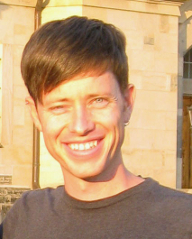Xylar Asay-DavisCNLS Postdoctoral Research Associate
CNLS/T-3 Ocean and Ice Sheet/Ice Shelf Climate Modeling, Planetary Science, Planet Formation 
Office: TA-3 Bldg 1690, Room 132
Mail Stop: B258
Phone: (505) 606-0025
Fax: (505) 665-2659 xylar@lanl.gov
home page |  | Educational Background/Employment:- B.S. (2001) Physics and Electrical Engineering, U.C. San Diego
- Ph.D. (2008) Applied Science and Technology, U.C. Berkeley
- Professional Training:
- 2008-2009 Postdoctoral Researcher, Department of Astronomy, UC Berkeley
- June 2010 Advanced Climate Dynamics Courses summer school on ice/ocean interactions, Lyngen, Norway
Research Interests: - Modeling ocean/ice shelf interactions in global climate simulations
- Immersed boundary methods for ocean and ice shelf/ice sheet modeling
- Unstructured grids
- Nonhydrostatic ocean modeling
- Observing and modeling Jupiter's atmospheric dynamics, particularly zonal flows and vortices
- Numerical modeling of planetessimal formation
Selected Recent Publications: - X.S. Asay-Davis, P.S. Marcus, M.H. Wong, I. de Pater, Jupiter's shrinking Great Red Spot and steady Oval BA: Velocity measurements with the `Advection Corrected Correlation Image Velocimetry' automated cloud-tracking method, Icarus. 203, Issue 1, September 2009, Pages 164-188, DOI: 10.1016/j.icarus.2009.05.001.
- A.T. Lee, E. Chiang, X. Asay-Davis, J. Barranco, Forming Planetesimals by Gravitational Instability. I. The Role of the Richardson Number in Triggering the Kelvin-Helmholtz Instability, The Astrophysical Journal, 718, Issue 2, 2010, Page 1367, DOI: 10.1088/0004-637X/718/2/1367. LA-UR 10-07179
- A.T. Lee, E. Chiang, X. Asay-Davis, J. Barranco, Forming Planetesimals by Gravitational Instability: II. How Dust Settles to its Marginally Stable State, The Astrophysical Journal, 725, Issue 2, 2010, Pages 1938-1954, DOI: 10.1088/0004-637X/725/2/1938. LA-UR 11-00703
- X.S. Asay-Davis, P.S. Marcus, M.H. Wong, I. de Pater, Changes in Jupiter's zonal velocity between 1979 and 2008, Icarus. 211, Issue 2, February 2011, Pages 1215-1232, DOI: 10.1016/j.icarus.2010.11.018. LA-UR 10-01896
|

